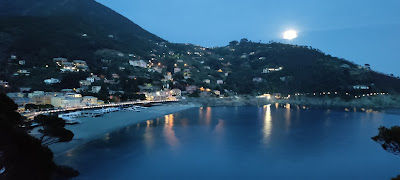We have just returned from two weeks in Limone sul Garda. I was leading walks for HF Holidays and it will probably be the last time I lead abroad.
There were about twenty guests on each week's holiday, some of whom had come all the way from the USA or Canada. There was a little bit of rain in the first week but none in the second week and it was lovely to have the warm weather just as things are cooling off in the UK. In fact it was summer when we flew out from Gatwick and it looks like Autumn now in Hebden Bridge.
Lake Garda is the largest of the Italian lakes and is very popular with kite surfers, wind surfers and paddle boarders. The transport to the start of most of the walks was by ferry and the captain often had to sound the horn to clear them out the way. There is a cable car to the top of Monte Baldo that overlooks the lake and parascenders make use of it to fly high up over the lake.
 |
| Arriving back in Limone on the ferry. |
Limone was the most northerly producer of lemons at one time and to achieve this they built Lemon Houses to keep the lemon trees in. The walls of these were posts that they could put wood and glass between to keep the trees at the right temperature. Lemons were not the only citrus fruit they grew. They also grew sour orange, sweet orange, citron, lime, mandarin, grapefruit, pomelo and bergamot. Many of these were grown by grafting them onto the root stock of a sour orange tree because it was a lot more hardy.
 |
| An old Lemon House |
Sadly the lemon trees were infected by gummy disease, the army took away the boards and glass for WW1, there was an exceptionally cold winter, artificial citric acid was discovered and it was easy to grow lemons further south. These all contributed to the loss of the lemon tree business. Nevertheless enthusiasts have recreated a lemon house and it is well worth a visit. As is the wonderful Museum of Tourism.
 |
| Looking south over Malcesine |
This will probably be my last lead abroad. It was already the case that many provinces in Italy, France and elsewhere were insisting that local leaders be used. See my blog entry from 2019 for example. Post Brexit this now includes many more European countries including those where they speak German and Italian, the languages I can speak a little of. I'm not keen on leading in countries where I have practically no language skills so, unless the rules change, I'll just be leading in the UK.
There will be a role for a Tour Manager to meet guests at the airport, liaise with the hotel and organise social activities on an HF Holiday abroad but it's leading the walks I like most.
I have had a good run and I do entirely understand why you might not be too happy having someone fly out to your local area from the UK to lead walks when you are trying to earn a living as a guide.




